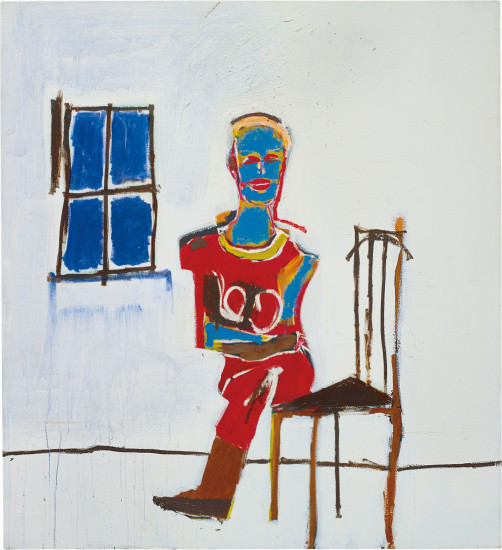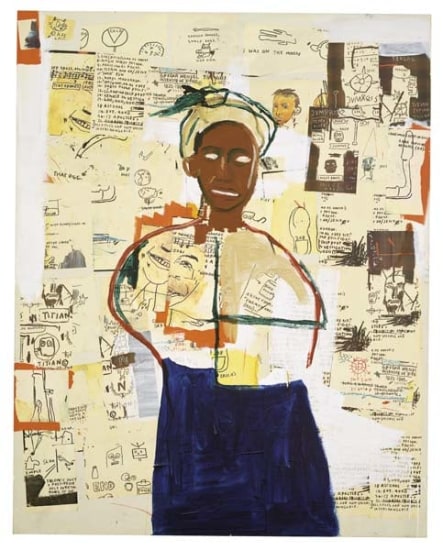Jean-Michel-Basquiat Untitled 1981 oilstick on paper 18 x 14 1/2 in. (45.7 x 36.8 cm) This work is accompanied by a certificate of authenticity issued by the Authentication Committee for the Estate of Jean-Michel-Basquiat.
Provenance Acquired directly from the artist Private Collection, Florida Private Collection, Texas Catalogue Essay It is believed that the spirit of Jean-Michel-Basquiat is best captured in his drawings. The unbridled flourish with which he marked paper in his short, tumultuous lifetime reveals a remarkable clarity of vision. Basquiat’s sketches are instinctive and raw, capturing life and the human condition with startling precision. Drawing, for him, was a compulsive practice, a way of life: “something you did rather than something done," Robert Storr once noted, "an activity rather than a medium" (D. Buchhart, Basquiat, exh. cat., Fondation Beyler, Basel, 2010, p. 10). The improvised scrawl canonized as the signature motif in Basquiat’s oeuvre is seen at its best in the following selection of three exceptional works on paper: Untitled, Untitled (head) and Untitled (skull). In these three works, the artist returns to one of his signature motifs – the human head. This focus on the figure is fundamental to the early drawings Basquiat created between 1981 and 1982 while working in the basement of Annina Nosei’s gallery on Prince Street in New York. With Untitled Basquiat layers different mark making strategies in order to develop a commanding, chromatically sophisticated, representation of the human head. A tangle of jade and olive green flourishes build up a face, marked with open, staring eyes and a vaguely defined mouth. The head pops forward against a screen of saffron yellow, loosely framed by lime and coral oil stick. Youthful pinwheel shapes, cross-hatched designs, and pointy crowns decorate the paper surface. Instinctive, yet concentrated, this drawing shows a human subject imbued with regal significance. In Untitled (head) Basquiat captures the exterior of the head with deliberate rawness, marking its basic forms in dove grey, turquoise, magenta, periwinkle and a warm violet oil pastel; these buoyant and whimsical colors contrast greatly to the usual deep reds and stern blacks common in 1981 and 1982. He depicts the cranium as lopsided, more rectangular than spherical, graphically suspended in the middle of the page. He circles the eye sockets with multiple irregular ovals, creating a sense of mysterious depth. The figure’s mouth, wide and gaping, is loosely suggested and a violently jagged line approximates a set of sharp teeth. Surgical stitches are hatched out on the forehead of the figure, adding to the overall half-living madness of the piece. With Untitled (skull) Basquiat ventures to represent what is beneath the skin. He dissects the human skull so that it takes on a primitive, mask-like quality. In his drawing, bone mass is reduced to a series of jagged, red forms. Oversized, square teeth protrude from a heavy, angular jaw. Two bulging eyeballs stare straight out into space. Basquiat manipulates colored oil pastel to create an effect of vibrant urgency. His choice of crimson makes the figure appear truly raw and exposed, as if a protective shell has been ripped violently away. An explosion of red and electric blue streaks bursts from the figure’s head, further heightening the psychical intensity of the work. The overall effect of Untitled, Untitled (skull), like Untitled (head), is one of unbridled, artistic fury. Taken as a trio, these drawings do not represent a particular figure, but rather provide a gripping exploration of human mortality. Basquiat’s treatment of this theme, and particularly his use of the skull motif, evidences inspiration from his predecessors. The raw intensity and scrawling quality with which he approaches the subject reflects the influence of Jean Dubuffet whose art brut eschewed then traditional standards of image making in favor of an instinctive, humanistic approach. In the late 1970s Warhol, a soon to be collaborator of Basquiat’s, also used the human skull in a series of his own screen printed works. Perhaps most influential is the fact that Basquiat’s own mother bought him a cop
Jean-Michel-Basquiat Untitled 1981 oilstick on paper 18 x 14 1/2 in. (45.7 x 36.8 cm) This work is accompanied by a certificate of authenticity issued by the Authentication Committee for the Estate of Jean-Michel-Basquiat.
Provenance Acquired directly from the artist Private Collection, Florida Private Collection, Texas Catalogue Essay It is believed that the spirit of Jean-Michel-Basquiat is best captured in his drawings. The unbridled flourish with which he marked paper in his short, tumultuous lifetime reveals a remarkable clarity of vision. Basquiat’s sketches are instinctive and raw, capturing life and the human condition with startling precision. Drawing, for him, was a compulsive practice, a way of life: “something you did rather than something done," Robert Storr once noted, "an activity rather than a medium" (D. Buchhart, Basquiat, exh. cat., Fondation Beyler, Basel, 2010, p. 10). The improvised scrawl canonized as the signature motif in Basquiat’s oeuvre is seen at its best in the following selection of three exceptional works on paper: Untitled, Untitled (head) and Untitled (skull). In these three works, the artist returns to one of his signature motifs – the human head. This focus on the figure is fundamental to the early drawings Basquiat created between 1981 and 1982 while working in the basement of Annina Nosei’s gallery on Prince Street in New York. With Untitled Basquiat layers different mark making strategies in order to develop a commanding, chromatically sophisticated, representation of the human head. A tangle of jade and olive green flourishes build up a face, marked with open, staring eyes and a vaguely defined mouth. The head pops forward against a screen of saffron yellow, loosely framed by lime and coral oil stick. Youthful pinwheel shapes, cross-hatched designs, and pointy crowns decorate the paper surface. Instinctive, yet concentrated, this drawing shows a human subject imbued with regal significance. In Untitled (head) Basquiat captures the exterior of the head with deliberate rawness, marking its basic forms in dove grey, turquoise, magenta, periwinkle and a warm violet oil pastel; these buoyant and whimsical colors contrast greatly to the usual deep reds and stern blacks common in 1981 and 1982. He depicts the cranium as lopsided, more rectangular than spherical, graphically suspended in the middle of the page. He circles the eye sockets with multiple irregular ovals, creating a sense of mysterious depth. The figure’s mouth, wide and gaping, is loosely suggested and a violently jagged line approximates a set of sharp teeth. Surgical stitches are hatched out on the forehead of the figure, adding to the overall half-living madness of the piece. With Untitled (skull) Basquiat ventures to represent what is beneath the skin. He dissects the human skull so that it takes on a primitive, mask-like quality. In his drawing, bone mass is reduced to a series of jagged, red forms. Oversized, square teeth protrude from a heavy, angular jaw. Two bulging eyeballs stare straight out into space. Basquiat manipulates colored oil pastel to create an effect of vibrant urgency. His choice of crimson makes the figure appear truly raw and exposed, as if a protective shell has been ripped violently away. An explosion of red and electric blue streaks bursts from the figure’s head, further heightening the psychical intensity of the work. The overall effect of Untitled, Untitled (skull), like Untitled (head), is one of unbridled, artistic fury. Taken as a trio, these drawings do not represent a particular figure, but rather provide a gripping exploration of human mortality. Basquiat’s treatment of this theme, and particularly his use of the skull motif, evidences inspiration from his predecessors. The raw intensity and scrawling quality with which he approaches the subject reflects the influence of Jean Dubuffet whose art brut eschewed then traditional standards of image making in favor of an instinctive, humanistic approach. In the late 1970s Warhol, a soon to be collaborator of Basquiat’s, also used the human skull in a series of his own screen printed works. Perhaps most influential is the fact that Basquiat’s own mother bought him a cop

.jpg)









Testen Sie LotSearch und seine Premium-Features 7 Tage - ohne Kosten!
Lassen Sie sich automatisch über neue Objekte in kommenden Auktionen benachrichtigen.
Suchauftrag anlegen